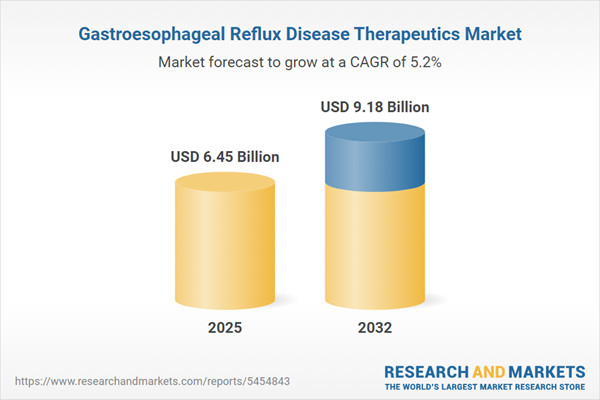Speak directly to the analyst to clarify any post sales queries you may have.
Senior executives operating in the gastroesophageal reflux disease therapeutics market navigate an environment defined by shifting compliance demands, rapid technology evolution, and the growing importance of patient-centric care. Success depends on anticipating regulatory trends and proactively aligning business strategies to maintain competitive resilience and growth within this specialized healthcare segment.
Market Snapshot: Gastroesophageal Reflux Disease Therapeutics Market
The gastroesophageal reflux disease therapeutics market is currently valued at USD 6.14 billion and is anticipated to reach USD 6.45 billion by 2025, supported by a projected CAGR of 5.16% through 2032. Growth is catalyzed by the emergence of innovative treatment protocols, increased integration of digital health solutions, and adoption of technologies streamlining regulatory and development activity. Precision medicine and advancements in drug delivery are also redefining both competitive intensity and performance benchmarks, requiring ongoing market adaptation. Organizations are urged to recalibrate strategies to remain agile and prepared for regulatory and operational fluctuations.
Scope & Segmentation
This analysis targets senior decision-makers seeking actionable perspectives to optimize investment and strategic planning in the gastroesophageal reflux disease therapeutics market. Segmentation captures the following core dimensions impacting resource allocation and market positioning:
- Treatment Types: Antacids, proton pump inhibitors, H2 receptor antagonists, and prokinetic agents address distinct treatment stages, facilitating tailored approaches for varied patient care requirements.
- Distribution Channels: Hospital pharmacies, retail outlets, and online platforms each broaden product accessibility, ensuring portfolio reach across traditional and emerging healthcare delivery models.
- Route of Administration: Oral and intravenous options support seamless transitions between intensive care settings and at-home management, expanding therapeutic flexibility and provider choice.
- Dosage Forms: Capsules, tablets, liquids, and suspensions empower clinicians and patients to maintain adherence and treatment continuity, irrespective of care environment.
- Patient End Users: Home-based care users, hospital patients, and specialty clinic populations help organizations design strategies aligned to distinct usage patterns and clinical needs.
- Geographic Coverage: Americas, EMEA, and Asia-Pacific regions each present unique regulatory structures and commercial environments, shaping market entry, pricing, and localization approaches.
- Industry Participants: Major pharmaceutical firms including AstraZeneca, Takeda, Johnson & Johnson, Pfizer, Sanofi, GSK, Bayer, Merck, Novartis, and Teva drive sector innovation pipelines and influence broader strategic trends.
Key Takeaways for Senior Decision-Makers
- Innovative drug delivery technologies are increasing the adaptability and usability of therapies to meet both clinical needs and patient lifestyle expectations.
- Strategic alliances between pharmaceutical and medtech organizations are fostering rapid digital transformation and optimizing management across diverse care settings.
- Integrated digital health platforms are enhancing patient engagement and supporting medication adherence, which translates into more consistent therapeutic outcomes.
- Diversified therapeutic portfolios allow companies to respond to evolving clinical practices and variable healthcare delivery models, improving market sustainability.
- Robust supply chain and distribution frameworks help mitigate the impact of regulatory change, supporting product availability and access in key global markets.
Tariff Impact on GERD Therapeutic Supply Chains
Adjustments in U.S. tariff policy are shaping costs and efficiency across GERD therapeutic supply chains. Market participants are refining procurement processes, strengthening strategic partnerships with suppliers, and optimizing logistics workflows to ensure uninterrupted product delivery and reliable patient access. Vigilant monitoring of global regulatory changes remains critical for operational stability amid these shifts.
Methodology & Data Sources
This research is developed through structured interviews with clinicians, healthcare executives, payer groups, and supply chain leaders. Verification is conducted against sources that include clinical trial data, official regulatory documents, and corporate financial disclosures to ensure accuracy and decision-making value.
Why This Report Matters for GERD Market Stakeholders
- Equips executive teams with the latest intelligence and trend analysis on innovation, regulatory change, and digital health, building a framework for agile strategy formulation.
- Clarifies operational influences shaping both near-term actions and long-term priorities, guiding resource investments across multiple market segments and geographic regions.
- Enables comprehensive benchmarking for competitive positioning and risk assessment, with insights grounded in rigorously validated data tailored to leadership requirements.
Conclusion
Organizations leveraging technological progress and sophisticated segmentation will be best equipped to address evolving market demands in GERD therapeutics. Continuous innovation and organizational flexibility provide a strong foundation for ongoing growth and strategic agility.
Additional Product Information:
- Purchase of this report includes 1 year online access with quarterly updates.
- This report can be updated on request. Please contact our Customer Experience team using the Ask a Question widget on our website.
Table of Contents
3. Executive Summary
4. Market Overview
7. Cumulative Impact of Artificial Intelligence 2025
List of Figures
Companies Mentioned
The companies profiled in this Gastroesophageal Reflux Disease Therapeutics market report include:- AstraZeneca PLC
- Takeda Pharmaceutical Company Limited
- Johnson & Johnson Services, Inc.
- Pfizer Inc.
- Sanofi S.A.
- GlaxoSmithKline PLC
- Bayer AG
- Merck Sharp & Dohme Corp.
- Novartis AG
- Teva Pharmaceutical Industries Ltd.
Table Information
| Report Attribute | Details |
|---|---|
| No. of Pages | 191 |
| Published | November 2025 |
| Forecast Period | 2025 - 2032 |
| Estimated Market Value ( USD | $ 6.45 Billion |
| Forecasted Market Value ( USD | $ 9.18 Billion |
| Compound Annual Growth Rate | 5.1% |
| Regions Covered | Global |
| No. of Companies Mentioned | 11 |









